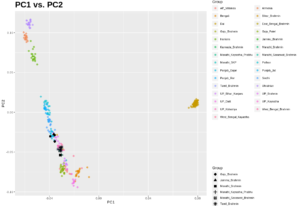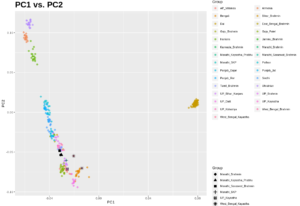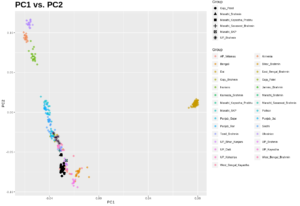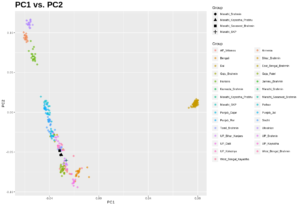 I periodically get inquiries on various issues relating to the genetic position/relatedness of various “communities” in the Indian subcontinent. Thanks to the South Asian Genotype Project I’ve got a rather large database to query such questions.
I periodically get inquiries on various issues relating to the genetic position/relatedness of various “communities” in the Indian subcontinent. Thanks to the South Asian Genotype Project I’ve got a rather large database to query such questions.
A reader asked about his own community, the Chandraseniya Kayastha Prabhu of Maharashtra. They are Kayasthas. The actress Kajol Mukherjee is also half CKP (on her mother’s side, obviously).
The PCA plots below should make it clear that the CKP is very close to the Maharashtra Brahmins I have in my samples. This is in contrast to the SKP, who are closer to Gujurati Patels.
Also, the generic Maharashtra Brahmin is closer to the CKP (there are two of these, but they are so close you can’t distinguish them) than it is the Maharashtra Sarswati Brahmin. And, these groups are a bit less “North Indian” than Tamil Brahmins.
Finally, I compared to other Kayastha and Brahmin groups. As is easy to predict, Kayasthas are genetically heterogeneous. I have two Bengali Kayastha. One of them is basically like a generic Bangladeshi. The other is between the Bangladeshis and the Bengali Brahmins on the PCA (both have lots of East Asian admixture). The UP Kayastha individual is close to the SKP, not the CKP.
Also, Guju Brahmins are very North Indian. As North Indian, or more so, than UP Brahmins.





these genetics threads get really long…but let me put some perspective in here:
aside from outlier groups like bengalis punjabis+pak groups munda and a few highly drifted tribals…most indian groups from UP to TN to Bihar to Maharashtra are within a relatively narrow band
Also can you explain “And, these groups are a bit less “North Indian” than Tamil Brahmins.” Do you mean ANI and how is this possible given geographic location?
Do you know if the generic Maharashtra Brahmins are Deshastha or Kokanastha (Chitpavan)? I know that might seem like splitting hairs.
surname indicates Deshastha Brahmin
Also can you explain “And, these groups are a bit less “North Indian” than Tamil Brahmins.” Do you mean ANI and how is this possible given geographic location?
That’s because Tamil Brahmins are relatively recent migrants (~1000-1500? years ago) to the South of India from the North right? (And a notoriously endogamous caste). I thought this was well known? I might be misremembering though.
What’s SKP?
Somvanshi Kshatriya Pathare
Suryavansh~ RamChandra
Chandravansh~ krsnBhagwan
?
Namaskar indeed.
???save GopiEyes
A reader posted previously, I think Son Goku (wish I knew him, perhaps the next Razib?) said that Bengalis are more related to Middle Eastern groups (although slightly) than East Asians like Chinese etc. It makes sense considering a huge West Eurasian proportion (Iran_HG + Steppe VS AASI + TB + AA) input, but honestly, I was heartbroken. When I found out about my East Asian heritage, I started feeling an inclination towards Chinese, even Japanese people lol.
PCA is showing a huge distance in relation to the Dai (VS other Near Eastern groups). Oh well.
“Guju Brahmins are very North Indian. As North Indian, or more so, than UP Brahmins.”
Not surprising, seems true for most gujju caste groups compared to UP. Assuming your earlier post is correct…
https://www.brownpundits.com/2019/09/07/the-intrusive-indo-aryans-had-a-huge-demographic-impact-on-south-asia/
Though the tendency is to have somewhat more IVC and somewhat less steppe and AASI in Gujarat.
I dont understand how groups all over the subcontinent have so much IVC related DNA but there are no archaeological sites outside of a certain area.
Maybe the just haven’t been discovered?
There are plenty of known IVC sites, only a few of them were big cities so you won’t hear about most of them in the news.
@razib
Can you place other Marathi communities on the graph.
Chitpavan Brahmins and Marathi/Kunbi and other OBCs Marathi ?
i can’t. i don’t have those samples. the recent kunbi paper authors didn’t make their data open access. if you want to email them feel free. i am sick of emailing authors and being told i can’t use their data.
@Razib Let’s see if I can add my and some other samples (mostly Chitpavan) post lockdown.
WTF? Seriously? Aren’t there any constraints by NIH and NSF on collecting the data in an appropriate manner and requirement to make them available to public? Does this behavior fly in Genetics research? In CS, especially in Machine Learning community, open data sets is all the rage.
it’s a little different for human research. but i think that was an indian group. i don’t know their rules. it’s become pretty common to deposit genotypes after pub tho. but not in this case
i don’t have a good track record of getting it from ppl who say “contact me” if i’m not an academic working on a specific topic (i’m not)
contactgnxp@gmail.com is where you send it. please note south asian genotype project and language+community
Also, the generic Maharashtra Brahmin is closer to the CKP (there are two of these, but they are so close you can’t distinguish them)
Since you say you don’t have Chitpavan, are you referring to Deshastha and Karade as the two groups?
Deshastha is Maharashtra Brahmin.
I know. Ah, so the “there are two of these” refers to two CKP groups?
(I parsed the sentence wrongly and thought you were referring to two brahmin groups, neither Chitpavan, so Deshastha and Karade.)
Ah, so the “there are two of these” refers to two CKP groups?
two CKP individuals
I see. Thank you for clarifying.
A reader asked about his own community, the Chandraseniya Kayastha Prabhu of Maharashtra.
the leading example now is the thakarey clan ruling maharastra now.
“The UP Kayastha individual is close to the SKP, not the CKP.”
Would you know the sub-caste (Srivastava, Saxena etc) or area of origin of the UP Kayastha individual?
Thanks for the post !
Mostly expected result but “… the generic Maharashtra Brahmin is closer to the CKP than it is the Maharashtra Sarswati Brahmin” seems interesting. Here the expectation would be other way round.
Quote / This is in contrast to the SKP, who are closer to Gujurati Patels./
Many communities from Konkan will follow this pattern. The konkan strip seems to be funnel (right upto kerala?) where people have more affinity to groups further north than adjacent people living on deccan plateau. chitpavan data can add more weight to this.
Quote / And, these groups are a bit less “North Indian” than Tamil Brahmins./
I see saraswat brahmin clustering with tamil brahmins. Can this be result of IVC vs Steppe percentages?
Can you make one for Mahar caste?
the ruling family in maharastra- the thakreys are ckp. they are very much anti brahmin.
Yep. They wouldn’t like these results. I’m curious if in future analyses, whether a CKP should use Maharashtra Brahmin and/or Tamil Brahmin as proxy to their own community? I ask because it’s not like any papers use CKP samples. They usually cite Tamil/Iyer Brahmin or maybe Deshastha Brahmin (haven’t seen a lot of those to be honest).